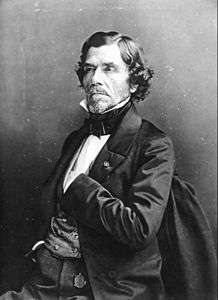Charles-François Delacroix
Charles-François Delacroix (or Lacroix; 14 April 1741 – 26 October 1805) was a French statesman who became Minister of Foreign Affairs under the Directory. The painter Eugène Delacroix was his fourth son, although doubts have been cast on his paternity.
Charles-François Delacroix | |
|---|---|
A bust of Charles-Francois in Bordeaux | |
| Born | 15 April 1741 Givry-en-Argonne, France |
| Died | 26 October 1805 (aged 64) Bordeaux, France |
| Nationality | French |
| Occupation | Statesman |
| Known for | Minister of Foreign Affairs |
Family
Charles-François Delacroix was born in Givry-en-Argonne on 14 April 1741.[1] He married Victoire Oëbène, daughter of the cabinet-maker Jean-François Oeben. Victoire's uncle Henri-François Riesener was a distinguished painter. They had four children.[2] Charles-Henri Delacroix (9 January 1779 – 30 December 1845) became a soldier, and rose to the rank of General in the Napoleonic army.[3] Henriette was born in 1780.[4] She married the diplomat Raymond de Verninac Saint-Maur (1762–1822).[5] Henri was born six year later. He was killed at the Battle of Friedland on 14 June 1807. The youngest child was the future painter Eugène Delacroix (1798–1863).[6]
When Eugène was born the gossip in Paris had it that Delacroix had been succeeded in his bed by the man who had succeeded him at his desk, Maurice de Talleyrand.[7] On 13 September 1797, the surgeon Imbert-Delonnes removed a "monstrous tumor" of twenty-eight pounds, in which were tangled "the most delecate masculine organs". The tumor apparently would have rendered him impotent.[8] Whatever the truth, it seems certain that Charles was sent away to the Hague to avoid the gossip.[9]
Career
Delacroix was secretary to Anne-Robert-Jacques Turgot, Baron de Laune (1727–1781), Minister of Finance during the reign of Louis XVI of France. During the French Revolution (1789–1799), he became a deputy to the National Convention and voted for the death of the king.[10] Delacroix interrogated Georges Danton, who was accused in 1793 in Belgium. In 1793 Delacroix proposed to the Convention to confiscate the metal statuary at Versailles and melt it down to make cannon. The proposal was rejected after some debate.[11]
Delacroix joined the Thermidorian Reaction.[10] He was appointed French Minister of Foreign Affairs between 3 November 1795 and 15 July 1797, when he was replaced by Talleyrand.[12] On 2 December 1797 he became a special envoy (ambassador) to the Batavian Republic. In January 1798 he advised Herman Willem Daendels in his coup d'état against a group of federalists in the Dutch National Convention. In 1799, he became the first prefect in the Bouches-du-Rhône and in 1803 in the Gironde.[13]
Delacroix died in Bordeaux on 26 October 1805.[1] When his wife, Victoire Oeben, died in 1814 it was found that family estate was fully mortgaged, and his attorney had been stealing from it. Rather than being worth 800,000 francs as thought, the estate was in debt by 175,000 francs.[14] A monument to Delacroix stands in the Chartreuse cemetery in Bordeaux.[15]
References
Citations
- Ramaer 1911, p. 367.
- Piron 1863, p. 34.
- Pouvesle 2013.
- Henriette de Verninac: Musée Delacroix.
- Société héraldique et généalogique de France 1886, p. 430.
- Sjöberg 1963, p. 29.
- Fraser 2004, p. 13.
- Fraser 2004, p. 14.
- Schama 1977, p. 298.
- Sinou-Bertault 2013, p. 14.
- Paris Sights 2010, p. 256.
- Ramaer 1911, p. 367-368.
- Ramaer 1911, p. 368.
- Riley 2001, p. 43.
- Auzias & Labourdette 2013, p. 69.
Sources
- Auzias, Dominique; Labourdette, Jean-Paul (20 September 2013). Habitat Bordeaux 2014 Petit Futé (avec cartes, photos + avis des lecteurs). Petit Futé. ISBN 978-2-7469-6635-2. Retrieved 16 March 2014.CS1 maint: ref=harv (link)
- Fraser, Elizabeth A. (2004). Delacroix, Art and Patrimony in Post-Revolutionary France (PDF). Cambridge University Press. ISBN 0-521-82829-5. Retrieved 2014-03-15.CS1 maint: ref=harv (link)
- "Henriette de Verninac (1780–1827)". Musée National Eugène Delacroix. Archived from the original on 2014-03-15. Retrieved 2014-03-15.
- Paris Sights: A Travel Guide to the Top 45 Attractions in Paris, France. MobileReference. 2010. ISBN 978-1-60778-976-5.
- Piron, E. A. (1863). Eugéne Delacroix: sa vie et ses œuvres. J. Claye. Retrieved 16 March 2014.CS1 maint: ref=harv (link)
- Pouvesle, Frederic (27 June 2013). "Delacroix, Charles". Empire Histofig. Archived from the original on 16 March 2014. Retrieved 2014-03-16.CS1 maint: ref=harv (link)
- Ramaer (1911). "DELECROIX DE CONSTANT (Charles)". Nieuw Nederlandsch Biografisch Woordenboek. Retrieved 2014-03-16.CS1 maint: ref=harv (link)
- Riley, Charles A. (2001). Aristocracy and the Modern Imagination. UPNE. ISBN 978-1-58465-151-2. Retrieved 15 March 2014.CS1 maint: ref=harv (link)
- Schama, Simon (1977). Patriots and liberators. Revolution in the Netherlands, 1780-1813. New York: First American edition.CS1 maint: ref=harv (link)
- Sinou-Bertault, Éric (2013). Talleyrand et l'affaire X, Y, Z: étude historique. L'Harmattan. ISBN 978-2-343-00431-0. Retrieved 16 March 2014.CS1 maint: ref=harv (link)
- Sjöberg, Yves (1963). Pour comprendre Delacroix. Editions Beauchesne. GGKEY:021FPT3P5E8. Retrieved 15 March 2014.CS1 maint: ref=harv (link)
- Société héraldique et généalogique de France (1886). Bulletin. Retrieved 14 March 2014.CS1 maint: ref=harv (link)
External links
Eugène Delacroix (1798-1863): Paintings, Drawings, and Prints from North American Collections], a full text exhibition catalog from The Metropolitan Museum of Art
- https://web.archive.org/web/20080517081523/http://www.documents-anciens.com/fiche-181.html
- https://web.archive.org/web/20110716234551/http://www.recherche.fr/encyclopedie/Proc%C3%A8s_de_Georges_Danton_et_des_dantonistes
- http://www.ebabylone.com/encyclopedie_Charles-Fran%C3%A7ois_Delacroix.html%5B%5D
._D%C3%A9claration_des_Droits_et_des_Devoirs_de_l'Homme_et_du_Citoyen.jpg)
